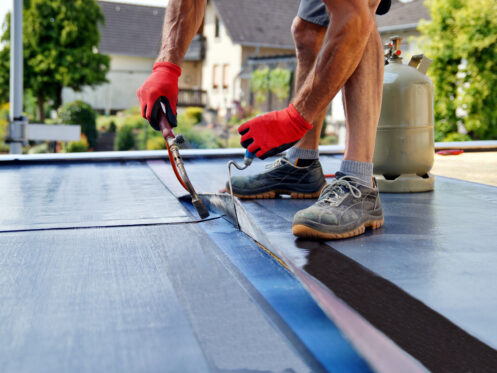When it comes to putting a new roof on your commercial building, the process can be challenging to start with. There are many different materials to choose from, each with its own pros and cons. One of the more popular options these days is to invest in a roof coating. We’re explaining what roof coatings are so you can decide whether to get one for your commercial building.
What Is a Roof Coating?
As its name suggests, a roof coating is an extra layer of protection placed on top of a completed roof. This protective layer helps to extend the lifespan of your roof and is available in many different materials. The most common include asphalt, acrylic, polyurethane, silicone, and elastomeric.
Energy Savings
One of the major benefits you can gain from using a roof coating is energy savings. Most roof coating materials are offered in a white or reflective shade to keep the building from absorbing heat from the sun. With less heat transfer happening, your building will stay cooler inside. This can go a long way in helping to reduce your air conditioning bills throughout the summer months.
Extra Leak Protection
The added layer on top of your roof protects it from leaks. This can be especially helpful when your existing roof has minor imperfections. The roof coating can seal them.
Extended Roof Lifespan
Another great benefit of roof coatings is they extend the overall longevity of your roofing system. It will allow your roof to do a better job of standing up to snow, hail, and ice. Also, by taking care of minor imperfections, a roof coating can be a great repair option to help your roofing components last for much longer.
Eco-Friendly
Roof coatings are a great alternative to replacing an entire commercial roof. You can extend the lifespan of the roof while preventing all the roofing components from hitting the landfill. Roof coatings are part of the U.S. Green Building Council’s Leadership in Energy and Environmental Design (LEED) program because of their ability to increase a building’s energy efficiency.
Sustainability
The beauty of roof coatings is that they’re not a one-and-done type of roofing system. Rather, they can be reapplied every 10 years to help extend the lifespan of your building’s roofing structure. Even if your roof coating starts to lose its reflectivity, you can simply add a new coating layer to restore its overall efficiency.
Quick and Easy Installation Process
Another major advantage of roof coatings is they’re super easy and quick to install. There’s not a lot of noise or excessive fumes being produced, so your building won’t have to be cleared out during the installation process. Instead of having to invest weeks in getting a new commercial roof for your building, you can complete a roof coating in a matter of days.
Silicone Roof Coating
Silicone is a great material for optimal UV radiation reflection, meaning that your commercial building can stay cooler during the summer months. Silicone is also ideal for areas with lots of temperature fluctuations due to its inherent flexibility. Unfortunately, silicone does tend to attract more dust and debris, so your roof will require regular cleaning. Plus, it can be quite slippery when wet.
Elastomeric Roof Coating
Much like silicone, elastomeric roof coating is very reflective of UV rays. This makes it ideal for helping to reduce your summer air conditioning bills. It’s also very strong and super easy to maintain, as it withstands small patch repairs much better than other roof coating materials. One of the drawbacks of using an elastomeric roof coating is that it doesn’t stand up well to pooling water.
Acrylic Roof Coating
Acrylic is relatively reflective, cost-effective, and very easy to install. It’s relatively resistant to dirt, making it much easier to maintain than other roof coating materials. However, acrylic has been known to get brittle when there is pooling water. It also can’t be adequately installed when the weather outside is cold.
Tips for Choosing the Right Roof Coating Material
Determining whether to go with elastomeric, acrylic, or silicone all starts with understanding the main factors to take into consideration. The first factor will be the weather that your roof regularly experiences. Buildings in dry, arid climates that receive tons of direct sunlight are going to benefit best from acrylic roof coatings. Silicone is ideal for environments that are warm and humid. Elastomeric stands up better in areas that experience severe weather.
If your roof experiences a lot of precipitation, and water tends to pool on it during heavy storms, then silicone may be your ideal choice. You can opt for using elastomeric or acrylic if you enhance your roof’s drainage system to ensure that there’s no pooling water. If you’re worried solely about being able to afford a roof coating on a shoestring budget, then acrylic will be the least expensive choice.
A Note on White Roofing
When selecting a new roof coating, there are various colors that you can go with. One of the most popular colors is white. White roofing allows for optimal UV reflectivity, which can help greatly to enhance the efficiency of your building’s air conditioning system. However, you need to realize that since white roofing is more prone to visible dirt and debris, it can require more frequent cleaning than roof coatings of other colors.
What Materials Can a Roof Coating Be Applied On?
Roof coatings are specifically designed to be able to cover a wide variety of roofing materials. Some of these include metal, TPO, EDPM, PVC, and asphalt. However, it’s important that the roofer who applies the coating takes the necessary precautionary steps to ensure that the new layer adheres properly. For example, EDPM roofing needs to have the right solvent to prevent the EDPM from swelling up after application.
A Note on Proper Installation
Preparation is a necessary step to ensure that your new roof coating adheres appropriately. All existing roofing issues should be repaired prior to application to ensure the longevity of your entire roofing structure. Any debris or dirt needs to be adequately removed from your roof, or the coating won’t stick. What’s more, any moisture that is on the initial roof and gets trapped between it and the new coating will prematurely deteriorate the new roof coat. It’s vital that your roof be 100% dry before receiving the coating.
A Trustworthy Commercial Roof Coating Service
Schmidt Roofing offers commercial roof coating service to the Burnsville, MN area. We can also help with all your residential roofing, siding, gutter, metal roofing, storm damage, snow and ice removal, and window and skylight needs.
Give us a call today to book a service consultation.



